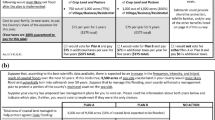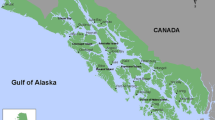Abstract
This paper investigates heterogeneity in the preferences/WTP (willingness to pay) to preserve marble monuments in Washington, D.C. This is done in the context of three different discrete-choice random-utility models. The main focus is to estimate a mixture model of choices over preservation programs. This model captures the best features of random-parameters models and models that assume preference parameters are deterministic functions of observable characteristics of the individual. The mixture model, and it alone, predicts that increased preservation is a bad for a significant proportion of young, non-Caucasians. That some proportion of the population might consider preservation a bad is a contingency that should be planned for in efforts to value cultural resources. Data and computer code are available athttp://www.colorado.edu/economics/morey/dataset.html.
Similar content being viewed by others
References
Adamowicz, W., Boxall, P., Williams, M., and Louviere, J. (1996) “Stated Preference Approaches for Measuring Passive Use Values: Choice Experiments versus Contingent Valuation”. Working Paper.
Ben-Akiva, M. and Lerman, S. (1985) Discrete Choice Analysis: Theory and Application to Travel Demand. The MIT Press, Cambridge, MA.
Bartholomew, D.J. and Knott, M. (1999) Latent Class Models and Factor Analysis. Oxford University Press.
Breffle, W.S. and Morey, E.R. (2000) “Investigating Preference Heterogeneity in a Repeated Discrete-Choice Recreation Demand Model of Atlantic Salmon Fishing”. Marine Resource Economics 15: 1–20.
Brownstone, D. and Train, K. (1999) “Forecasting New Product Penetration with Flexible Substitution Patterns”. Journal of Econometrics 89: 109–129.
Johnson, F. and Desvousges, W. (1997) “Estimating Stated Preferences with Rated-Pair Data: Environmental, Health, and Employment Effects of Energy Programs”. Journal of Environmental Planning and Management 34: 79–99.
Layton, D.F. and Brown, G. (2000) “Heterogeneous Preferences Regarding Global Climate Change”. The Review of Economics and Statistics 82 (4): 616–624.
Lee, L. (1992) “On Efficiency of Methods of Simulated Moments and Maximum Simulated Maximum Estimation of Discrete Response Models”. Econometrica 8: 518–552.
McFadden, D. and Ruud, P. (1994) “Estimation by Simulation”. The Review of Economics and Statistics 76: 591–608.
Morey, E.R. and Rossmann, K.G., Chestnut, L., and Ragland, S. (1997) “Valuing Acid Deposition Injuries to Cultural Resources”. Prepared for National Acid Precipitation Assessment Program.
Morey, E.R. and Rossmann K.G. (2003) “Calculating, with Varying Types of Income Effects, Closed-Form Solutions for the Compensating Variation Associated with a Change in the State of the World”. Discussion paper at http://www.colorado.edu/economics/morey/discuss.html.
Morey, E.R. and Rossmann, K.G., Chestnut, L., and Ragland, S. (2002) “Modeling and Estimating E[WTP] for Reducing Acid Deposition Injuries to Cultural Resources: Using Choice Experiments in a Group Setting to Estimate Passive-Use Values”, in Stale Narvud and Richard Ready (eds.), Valuing Cultural Resources. Edward Elgar Publishing.
Morey, E.R., Sharma, V.R., and Karlstrom, A. (2003) “A Simple Method of Incorporating Income Effects into Logit and Nested-Logit Models: Theory and Application”. American Journal of Agricultural Economics 85(1): 250–255.
Revelt, D. and Train, K. (1998) “Mixed Logit with Repeated Choices: Households' Choices of Appliance Efficiency Level”. Review of Economics and Statistics 80(4): 647–657.
Roe, B. and Boyle, K.J., Teisl, M.F. (1996) “Using Conjoint Analysis to Derive Estimates of Compensating Variation”. Journal of Environmental Economics and Management 31: 145–150.
Stevens, T.H., Barrett, C., and Willis, C.E. (1997) “Conjoint Analysis of Groundwater Protection Programs”. Agricultural and Resource Economics Review October, 229–236.
Swait, J., Adamowicz, W., and Louviere, J. (1998) “Attribute-Based Stated Choice Methods for Resource Compensation: An Application to Oil Spill Damage Assessment”. Prepared for presentation at the Natural Resources Trustee Workshop on Applications of Stated-Preference Methods to Resource Compensation, Washington, D.C., June 1–2, 1998.
Titterington, D.M., Smith, A.F.M., and Makov, U.E. (1985) Statistical Analysis of Finite Mixture Distribution. John Wiley and Sons.
Train, K.E. (1998) “Recreation Demand Models with Taste Differences over People”. Land Economics 74(2): 230–239.
Train, K.E. (2003) Discrete Choice Methods with Simulation. Cambridge University Press.
Wedel, M. and Kamakura, W. (2000) Market Segmentation: Conceptual and Methodological Foundations (second edition). Kluwer Academic Publishers.
Author information
Authors and Affiliations
Rights and permissions
About this article
Cite this article
Morey, E., Greer Rossmann, K. Using Stated-Preference Questions to Investigate Variations in Willingness to Pay for Preserving Marble Monuments: Classic Heterogeneity, Random Parameters, and Mixture Models. Journal of Cultural Economics 27, 215–229 (2003). https://doi.org/10.1023/A:1026365125898
Issue Date:
DOI: https://doi.org/10.1023/A:1026365125898




